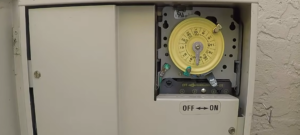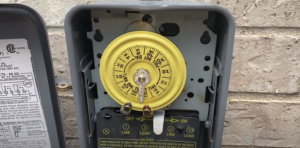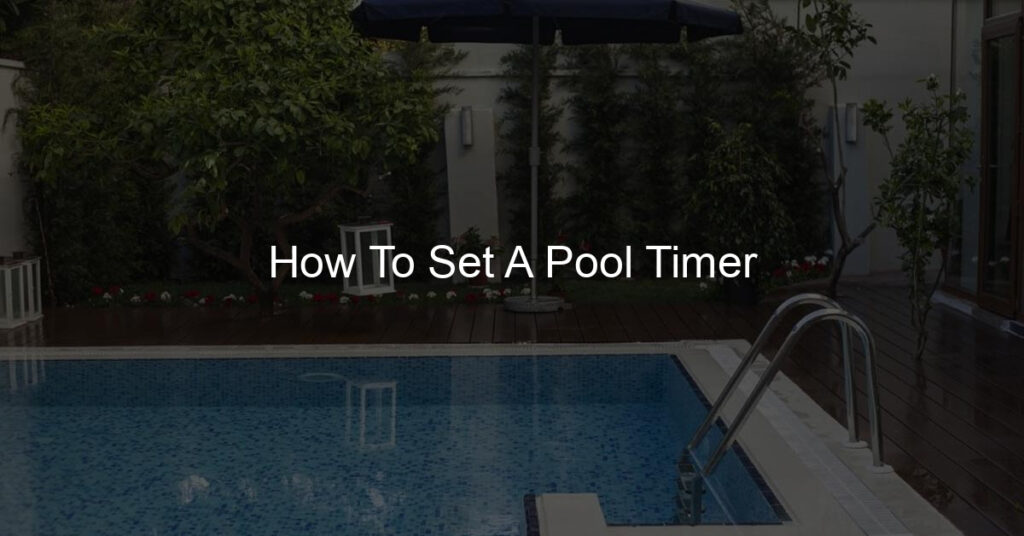Setting a pool timer is an easy task if you have the right knowledge, but it can be quite challenging as well. Most people don’t know how to set a pool timer. Even if you do know, setting timers for pools isn’t always straightforward.
You need to consider various features and factors that might make the task challenging. That being said, with the right information and guidance, setting timers for your pool shouldn’t be difficult at all!
This article provides tips on how to set a pool timer properly so that you can take advantage of its convenient features without wasting time and energy resetting it over and over again.
How do you set the timer on a pool pump?
| Steps to Set A Pool Timer | Description |
|---|---|
| Step 1: Locate the pool timer | Find the timer switch or dial, usually located near the pool equipment or on a nearby wall. |
| Step 2: Set the time | Adjust the time to match the current time of day using the switch or dial. Some pool timers have digital displays and buttons to set the time. |
| Step 3: Set the on/off schedule | Determine when your pool equipment should turn on and off each day. Use separate switches or dials on the timer to set the on/off schedule for each piece of equipment. |
| Step 4: Test the timer | Turn on your pool equipment and check that it turns off at the scheduled time. If necessary, adjust the schedule or settings. |
| Step 5: Fine-tune the settings | Make any necessary adjustments to the schedule or settings based on factors such as the changing seasons, weather conditions, or pool usage. |
| Step 6: Save the settings | Save the settings so that they are not lost if the timer loses power or is turned off. |
Setting a timer for your pool pump is easy! You just need to follow a few simple steps.
First, find the current time on the timer by pressing the ON/OFF button. You can use a smartphone with a timer app or put your smartphone near the control panel to see what time it currently is.
Next, adjust the desired time by pressing the arrow buttons until you reach your desired time. Then press OK to start the timer and close it by pressing again OK.
Finally, press the ON/Off button to turn off the pump if needed, and remember to reset it when you’re done swimming!
Find the right pool timer for your existing pool setup
As a pool owner, you know that keeping the water crystal clear and refreshing takes some effort. It’s not just about skimming the surface and adding chemicals, but also making sure that your pool runs efficiently. With a timer, you can automate the pool’s pump and other equipment, ensuring that everything runs on schedule and saving you money in the process.
That’s where a pool timer comes in handy. The challenge, of course, is finding the right pool timer for your existing setup. There are lots of options, ranging from simple manual switches to sophisticated digital controls.
It all depends on your pool’s needs and your personal preferences. But with a little research and some expert guidance, you can find the perfect timer to keep your pool in top shape all year round.
What is the use of a pool timer?

If you’re a swimming pool owner, you know that maintaining your pool can be a time-consuming task. A pool timer is a device that allows you to automate the process of turning your pool pump on and off. With a pool timer, you can set specific times for your pump to turn on and off, which can help to conserve energy and reduce your pool maintenance costs.
Additionally, the use of a pool timer can help to keep your pool water cleaner by ensuring that the pump is running at optimal times. So, if you’re looking to simplify your pool maintenance routine and save a little money in the process, consider investing in a pool timer.
How do you use a pool clock?

A pool clock is an essential tool for any swimmer, whether you’re a beginner or a pro. Using a pool clock may seem intimidating at first, but once you understand how it works, it’ll help you tremendously in your training. A pool clock allows you to time your laps and focus on improving your pace, stroke, and overall swimming technique.
Simply start the clock when you enter the water and stop it when you finish your lap. By keeping track of your time, you’ll be able to set goals for yourself and see how you improve over time. Whether you’re training for a competition or just trying to stay in shape, a pool clock will be your best friend in the water.
How do I reset my pool clock?
Having a pool is a great way to cool off during the hot summer months, but sometimes its maintenance can be a little tricky. If you’re having trouble resetting your pool clock, there’s no need to stress. Most pool clocks can be easily reset by simply following a few basic steps.
Start by locating the “reset” button on your clock and holding it down for a few seconds. After release, the clock should go blank and then restart. Next, use the buttons on the clock face to adjust the time to your desired setting. If you’re still having trouble, consult your pool’s instruction manual or reach out to a pool maintenance professional. With a little bit of effort, your pool clock will be back up and running in no time.
different types of pool timers

Pool timers are a great way to make sure your pool is always ready for use when you are. However, not all pool timers are created equal. There are several different types of pool timers available, each with its own set of features and benefits.
For example, there are manual pool timers, which require you to manually adjust the settings each time you want to turn your pool on or off. Alternatively, there are digital pool timers with programmable settings that allow you to set your pool to turn on and off at specific times and intervals automatically. No matter what type of pool timer you choose, having one is sure to make pool maintenance a breeze.
How long do pool timers last?
Pool timers are a crucial component of any swimming pool system. They allow you to control when your pool equipment turns on and off, giving you the ability to conserve energy and save money on your electricity bill. While the lifespan of a pool timer can vary depending on the make and model, most will last anywhere from 5 to 10 years with proper maintenance.
However, it’s not uncommon for them to fail prematurely due to power surges, moisture, or general wear and tear. If you suspect that your pool timer might be on its last legs, it’s important to have it inspected by a certified technician as soon as possible to avoid any potential malfunctions or hazards.
How do I get my pool timer to work?
Most pool timers work with a small mechanism that sits on the edge of your pool and rocks back and forth. These mechanisms are activated by your timer’s controller. If you aren’t sure how to set up your timer, you will need to hold down the button on the timer for 3 seconds to activate it.
This is a simple process that shouldn’t take more than a few minutes. When you want your timer to stop, make sure you press the off button on your controller. The timer should now be ready for use!
How do I set the timer on my above-ground pool pump?
If you have an above-ground pool, chances are you also have a pool pump. One of the most important parts of owning a pool is having a pool pump. Pools can be extremely expensive to maintain, so it’s important that you take care of your investment.
Your expensive pump will function much better if it has a timer attached to it. The secret to setting the timer on your pool pump properly is knowing how to set this timer correctly.
To set the timer for your pool, you need to know which type of timer your pump uses and what features it offers. You also need to know how many seconds each part of the cycle takes as well as how often each part of the cycle happens throughout the day or week.
Some types of timers typically found on pumps are:
Electronic: This type is easiest because all you do is plug one cord into an outlet and another cord into your machine. It has no dials or buttons, so there’s no guesswork involved!
Wired: This type requires two cords and usually just one switch on the side, making it easier than electronic timers but not as straightforward as mechanical timers.
Mechanical: Mechanical timers are also known as “hand-cranked” timers because they require more effort than other types of pumps. They often come with hand-crank handles and crank gears so that you can manually rotate them around when needed (instead of turning an electric power switch).
What time should you set the pool timer?
Before you start setting your pool timer, there are a few things you need to consider. First, you should consider when the pool is open and closed. If the pool is open 24 hours a day, then it’s best to leave the timer on continuously.
If your pool is open for a certain period of time or opens and closes at certain times of the day, then it’s best to set up a timer so that the pump shuts off automatically at the appropriate time.
Next, you need to consider how long you want your pool to be filled before draining. This will depend on several factors like what type of filter you have in your pool and how often you drain it (i.e., weekly or monthly).
Finally, consider what kind of filter you want your water to pass through before reaching your home’s water supply. What kind of filtration system does your home use? Is it activated carbon or ozonated? These choices will also affect how long the pool should be filled before draining out into the yard garden.
With these considerations in mind, here’s how to set a timer for your pool!
Conclusion
All in all, a pool timer is an essential part of any pool setup. The right one for you will depend on the type of pool you have and its existing setup. Be sure to pay attention to the type of timer you get so that it works with both your specific system and types of appliances you are using.
With the right amount of research, determining which timer to use can be hassle-free. Finally, don’t forget to follow directions when resetting your clock, as even a few minutes may mean precious energy savings or costly equipment breakdowns. Remember – if used correctly and safely, a pool timer will help ensure you enjoy optimal comfort and energy savings while still enjoying the many benefits of swimming.














